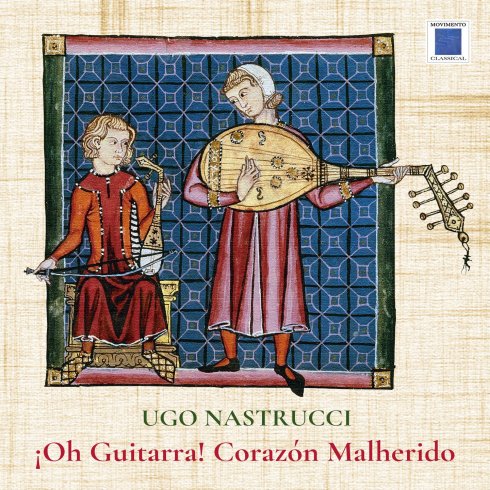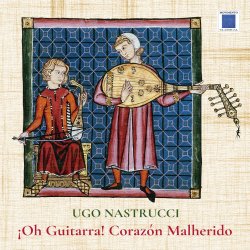

¡Oh Guitarra ! Corazon Malherido
Five centuries of Spanish music
Qanbüs, üd, vihuela, guitar, four different instruments that to some extent represent the passage of Spanish music from its origins, still linked to the Arab tradition, to the heart of European civilisation, in the middle of the 18th century; we could therefore see this recording as a kind of history of the penetration of plucked string instruments of oriental origin into Europe. which led from Arab lutes, qanbüs and üd, to European lutes. In this case, we are talking about the 'Spanish' version of the Jute, the vihuela, and its Baroque 'daughter', the five-order guitar, known at the time as guitarra espafiola or simply guitar ra, in Italy chitarra a la spagnuola . Our journey therefore begins with three Cantigas de Santa Maria, hyrnns to the Virgin collected, and possibly some composed in person by King Alfonso Decimo 'the Wise' of Castile. We have chosen to play two of them on the qanbüs, an instrument of the Jute family consisting of a single block of hollowed-out wood, undoubtedly derived from the Persian barbat and probable progenitor of the üd, the Arab Jute, still played today throughout the Mediterranean area. The choice is not accidental: in the abundant iconography relating to the Cantigas one can observe instruments very similar to the üd and qanbüs in shape and size. The qanbus used in this recording, made by an unknown Yemenite luthier, could considered a 'historical fossil', an instrument that survived the centuries in the construction traditions of areas other than Western Europe . We wanted to illustrate the transition from the Middle Ages to the Renaissance as a symbolic "handing over ofthe baton" by perforrning first on the üd, then on the vihuela the Propifian de Melyor.This anonymous piece, contained in the Cancionero de la Colombina, written roughly between 1460 and 1480, nevertheless shows an archaic style, which is weil suited to an 'older', monodic perforrnance, with the üd, as weil as to polyphonic perforrnance in three voices with the vihuela. From this moment on we enter the Renaissance, the Siglo de oro, the 'Golden Age' of Spanish culture and power. The vihuela, a flat-bottomed 'Latin' instrurnent, as opposed to the round, sensuous shapes of the Arab lutes, became the true 'king' of instrumental music in this period; this instrurnent constitutes a special case in the history of music: practically extinct (very few instuments survived, the reconstructed ones we use are generally not copies ofthe originals but are derived by iconography); only seven composers wrote for it (Luys Milan, Luys de Narväez, Diego Pisador, Alonso Mudarra, Enriquez de Valderrabano, Esteban Daza, Miguel de Fuenllana). Despite this, the amount ofliterature is impressive: transcriptions ofvocal music by major Renaissance composers, (to name but a few: Josquin Desprez, Crist6bal de Morales, Nicholas Gombert, Adrian Willaert, Jacques Arcadelt), original Fantasias for the instrument, Tientos, Pavans with variations, Bicinia and whatnot; noted in tablature, many compositions are conceived as adaptable to a vocal-vihuela ensemble: the notes to be sung are printed in red font with text undemeath, the remainder in black. In our recording we have included a variety ofpieces from the repertoire for vihuela solo: the famous Six Pavanes by Luys Milan, Fantasias by Milan, Narvaez, Mudarra, two sets of variations (diferencias) made on well-known pieces ofthe time: the Cuatro diferencias sobre la pavana por grados, on the Italian aria La Gamba, and the Siete diferencias faciles sobre «Guardame las vacas» by Valderraba no, as weil as the Canci6n de! Emperador, by Narvaez, a transcription of the famous Chanson Mille Regretz by Josquin, the favourite tune of Emperor Carlos V.
The CD concludes with a part dedicated to the guitar: an instrument with five courses of strings in 'reentrant' tuning, i.e. with the fifth or fourth and fifth courses in the upper octave. For our recording, we opted for the tuning to the upper octave of both orders, since both Sanz and Santiago de Murcia often make use of a particular technique, the campanelas: the reentrant tuning makes it possible to maintain a fixed position ofthe left hand when playing fast scales, generating a sort of 'harp effect', or indeed, 'small bells'. We have brought together in a kind of Suite a series of pieces, usually dances, from the Instrucci6n de musica sobre la guitarra espaiiola by Gaspar Sanz (Zaragoza, 1697), one of my improvised Preludes (Capricho arpeado sobre Marinilla) and inserting the piece Las Penas by Santiago de Murcia. lt should come as no surprise that some ofthe dances are different from what is noted in Sanz's work: this is due to the improvisational proce dures, which were anything but foreign to the performance practice of the time. Already Juan Carlos Amat had ecogitated a system of numerical notation with which Puedense con estos puntos hazer vacas, passeos, gallardas, villanos.. (one can with these notation make vacas [Romanesque Guardame las vacas), passacagli, gallardas, villanos... [Barce lona 1596]); then there was the introduction of the so-called Alfabeto ltaliano by Girola mo Montesardo (Nuova invenzione d'intavolatura per sonare li balletti... [1606]), giving rise to a vast production of books for guitar, played with the technique of tom chords (botte, or ragueado) based on this system: letters to define the chords, and a single line with vertical bars to determine whether the strappata should be given "up" or "down". If precise passages are desired, alphabetical notation is mixed with the normal staff of the tablature.Sanz himself goes one step further: in his lstrucci6n he provides a 'labyrinth' obtained with the letters of the chords of the Italian alphabet, using which everyone can construct their own Passacalles, Villanos and whatnot. Thus, ifpieces such as Espaiioleta and Lantururu closely follow the tablature proposed by Sanz, others such as Pasacalles, Villanos and La Tarantela, notated in the original work with the Montesardo system,
(a single line with the letters of the Alphabet), have been completely reworked in the improvised version. In the case of Canarios, an 'intermediate route' was used: practically adhering to the original in the first part, a second part was added in rasgueado, using improvisational techniques. The resulting Suite is conceived as a single piece: The Pasacalles serve as the opening, followed by a series of dances from Sanz, interrupted by my Capricho arpeado that leads to the change of atmosphere of La Tarantela and then to Las Penas by Santiago de Murcia. A link then Jeads back to Pasacalles introducing the final track, Canarios a sort of 'fiesta', which concludes the recording..



